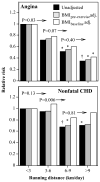Reductions in incident coronary heart disease risk above guideline physical activity levels in men
- PMID: 19815208
- PMCID: PMC3776591
- DOI: 10.1016/j.atherosclerosis.2009.09.018
Reductions in incident coronary heart disease risk above guideline physical activity levels in men
Abstract
Background: One-half of Americans currently meet guideline physical activity levels. For these individuals, exceeding guideline levels may provide additional health benefits.
Methods: Incident physician-diagnosed myocardial infarction and angina, revascularization procedures (CABG, PTCA), and ischemic heart disease deaths during 7.7-year follow-up were compared to baseline usual distance run in 35,402 male runners.
Results: Men reported 467 incident CHD and the National Death Index identified an additional 54 ischemic heart disease deaths. Per km/day run, the men's risks declined 5% for fatal and nonfatal CHD (P=0.001), nonfatal CHD (P=0.0008), and revascularization procedures (P=0.002). Their risks for nonfatal myocardial infarctions and angina declined 7% (P=0.02) and 10% (P=0.003), respectively. Compared to <3km/day run (upper limit guideline level), >9km/day run produced risks 65% lower for angina (P=0.008), 29% lower for nonfatal CHD (P=0.04), and 26% lower for fatal and nonfatal CHD (P=0.06).
Conclusions: Exceeding guideline physical activity levels produce important CHD-risk reductions.
Copyright 2009. Published by Elsevier Ireland Ltd.
Figures

References
-
- Haskell WL, Lee IM, Pate RR, et al. American College of Sports Medicine; American Heart Association, Physical activity and public health: updated recommendation for adults from the American College of Sports Medicine and the American Heart Association. Circulation. 2007;116:1081–93. - PubMed
-
- Ainsworth BE, Haskell WL, Whitt MC, et al. Compendium of physical activities: an update of activity codes and MET intensities. Med Sci Sports Exerc. 2000;32(Suppl):S498–516. - PubMed
Publication types
MeSH terms
Grants and funding
LinkOut - more resources
Full Text Sources

